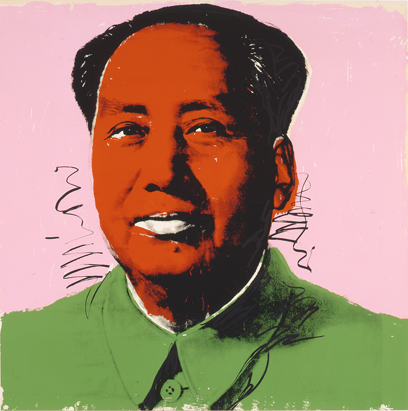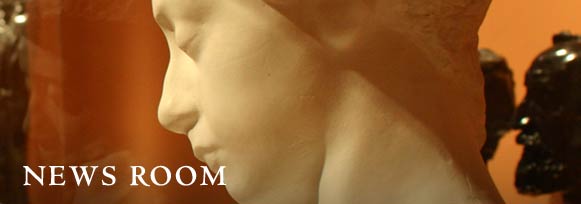Major 20th-Century Works Enter Cantor Arts Center Collection
Acquisitions of works by Noguchi, Abakanowicz, and Warhol
Stanford, California, March 22, 2010 — Cantor Arts Center at Stanford University announces the addition of major works to its collection. Two of the acquisitions are purchases of sculpture by artists Isamu Noguchi and Magdalena Abakanowicz. The third acquisition is the donation of screenprints of Mao Tse-Tung by Andy Warhol. The sculptures by Noguchi and Abakanowicz enhance a collection of 20th-century sculpture that already includes works displayed at the museum and throughout campus by artists such as Joan Miró, George Segal, Jacques Lipchitz, Gaston Lachaise, Elie Nadelman, Raymond Duchamp-Villon, Henry Moore, and Jean Arp.
“Thanks to our longtime loyal friends and to new donors, I am happy to say that we added 160 works to the collection in 2009,” said Thomas K. Seligman, director of the Cantor Arts Center. “Late last year, gifts enabled the acquisition of the Isamu Noguchi bronze sculpture Victim, one of the most significant acquisitions the Center has made during my 18-year tenure as director, plus the marvelous sculpture Sage E by Magdalena Abakanowicz, and an important series of prints by Warhol. With acquisitions such as these, we are exponentially raising the quality of the Center’s collection, which will provide for future engaging and educational presentations.”
A work by innovative Asian-American sculptor Isamu Noguchi has long been on the museum’s wish list. Victim was cast shortly before Noguchi’s death in 1988 and is number four in an edition of six bronzes that was first produced in 1962. The son of a Japanese poet and an American translator, Noguchi is well known for his work, which includes landscape architecture, stage sets, and mass-produced lamps and furniture. Born in Los Angeles and trained in Europe, Noguchi traveled to Japan during his lifetime and was exquisitely attuned to issues of Japanese-American relations. In Victim, Noguchi wedded the characteristic simplicity of his design with a profound evocation of despair to create a sculpture that speaks silently and eloquently about the tragedy of war, devastation, and inhumanity. Victim has entered the collection thanks to donors Jill and John Freidenrich, Deedee and Burton McMurtry, Marilynn and Carl Thoma, and Bobbie and Mike Wilsey, and Cantor Arts Center funds.
Abakanowicz, born in Poland in 1930, has created sculptures that profoundly reflect the years of war and oppression that she witnessed as a child and in her life behind the Iron Curtain. “Although her art stems from her personal history, the figures she creates partake of universal artistic language relating to themes of alienation, individualism, and community,” explained Hilarie Faberman, curator of modern and contemporary art. “Sage E is one of a number of seated, headless torsos inspired by a group of sculptures originally made in burlap. When realized in bronze in 1990, the form was simplified — the hands were placed on the figure's lap and melded into the knees, making the subject more monolithic and iconic. As in many of Abakanowicz's works, the ceramic shell remains on the roughly textured surface; this patination gives the work the appearance of having just been excavated.” The acquisition of Sage E was made possible by a bequest from Jane B. Miller and the Center’s Modern and Contemporary Art Fund.
The third acquisition is a series of color portraits of Mao Tse-Tung, created in 1972 by Andy Warhol. Much of Warhol’s output — whether painting, works on paper, or sculpture — concerns issues of celebrity, reproduction, and authenticity. Perhaps in no series do these issues intertwine as seamlessly as in the Mao screenprints. Each of the images in the series varies the color of the sitter’s face and costume, as well as the shape of the energetic black squiggles around him. Museum of Modern Art curator Kynaston McShine wrote eloquently about Warhol’s image of Mao: “If Warhol can be regarded as an artist of strategy, his choice of Mao as a subject — as the ultimate star — was brilliant. The image of Mao, taken from the portrait photograph reproduced in the chairman’s so-called Little Red Book, is probably the one recognized by more of the world’s population than any other — a ready-made icon representing absolute political and cultural power. In Warhol’s hands this image could be considered ominously and universally threatening, or a parody, or both.” The Mao prints are a gift of the Marmor Foundation (Drs. Michael and Jane Marmor) from the collection of Drs. Judd and Katherine Marmor, and are part of the Marmor Foundation’s generous ongoing donations to the Center.
Sage E by Abakanowicz and Victim by Noguchi are on view in the museum’s H. L. Kwee Galleria. Warhol’s portraits of Mao Tse-Tung were on view in 2009, while on loan from the Marmor Foundation.
# # #
VISITOR INFORMATION: Cantor Arts Center is open Wednesday – Sunday, 11 am – 5 pm, Thursday until 8 pm. Admission is free. The Center is located on the Stanford campus, off Palm Drive at Museum Way. Parking is free after 4 pm and all day on weekends. Information: 650-723-4177, museum.stanford.edu.
PUBLICITY IMAGES: To obtain publicity images of the artworks, contact PR Assistant Manager, Margaret Whitehorn:
650-724-3600, mmwhite@stanford.edu
2009 Acquisitions, learn more

Isamu Noguchi (U.S.A., 1904–1988)
Victim, 1962 (cast 1988) Bronze. Cantor Arts Center, Museum purchase made possible by gifts from Mr. and Mrs. John Freidenrich, Burton and Deedee McMurtry, Marilynn and Carl Thoma, Bobbie and Mike Wilsey, and the Modern and Contemporary Art Fund, 2009.96. © 2010 The Isamu Noguchi Foundation and Garden Museum, New York/Artists Rights Rights Society (ARS), New York

Magdalena Abakanowicz (Poland, b. 1930)
Sage E, 1990
Bronze.Museum purchase made possible by the Jane B. Miller Bequest and the Modern and Contemporary Art Fund, 2009.48.a-b

Andy Warhol (U.S.A., 1928–1987)
Mao Tse-Tung, 1972 Screenprint. Cantor Arts Center, Gift of the Marmor Foundation, 2009.94.4. ©2010 The Andy Warhol Foundation for the Visual Arts, Inc./Artists Rights Society (ARS), New York



